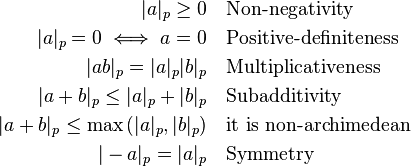p-adic order
In number theory, for a given prime number p, the p-adic order or p-adic additive valuation of a non-zero integer n is the highest exponent ν such that pν divides n. The p-adic valuation of  is defined to be
is defined to be  . It is commonly abbreviated νp(n). If n/d is a rational number in lowest terms, so that n and d are relatively prime, then νp(n/d) is equal to νp(n) if p divides n, or -νp(d) if p divides d, or to 0 if it divides neither one. The most important application of the p-adic order is in constructing the field of p-adic numbers. It is also applied toward various more elementary topics, such as the distinction between singly and doubly even numbers.[1]
. It is commonly abbreviated νp(n). If n/d is a rational number in lowest terms, so that n and d are relatively prime, then νp(n/d) is equal to νp(n) if p divides n, or -νp(d) if p divides d, or to 0 if it divides neither one. The most important application of the p-adic order is in constructing the field of p-adic numbers. It is also applied toward various more elementary topics, such as the distinction between singly and doubly even numbers.[1]

Definition and Properties
Integers
Let p be a prime in Z. The p-adic order or p-adic valuation for Z is defined as[2] 
Rational Numbers
The p-adic order can be extended into the rational numbers. We can define[3] 
Some properties are:

 Moreover, if
Moreover, if  , then
, then 
where  is the Infimum (i.e. the smaller of the two)
is the Infimum (i.e. the smaller of the two)
p-adic Norm
From our definition of the p-adic order, we can define the so-called p-adic norm. (It is not actually a norm because it does not satisfy the requirement of homogeneity, but it is an absolute value.) The p-adic norm of Q is defined as 
Some properties of the p-adic norm:
A metric space can be formed on the set Q with a (non-archimedean, translation invariant) metric defined by 
See also
References
- ↑ David S. Dummit; Richard M. Foote (2003). Abstract Algebra (3rd ed.). Wiley. ISBN 0-471-43334-9.
- ↑ Ireland, K., Rosen, M. (2000). A Classical Introduction to Modern Number Theory. Springer-Verlag New York. Inc., p. 3
- ↑ Khrennikov, A., Nilsson, M. (2004). P-adic Deterministic and Random Dynamics., Kluwer Academic Publishers, p. 9




